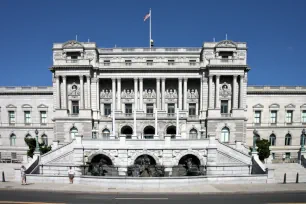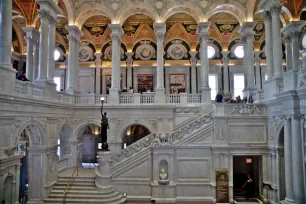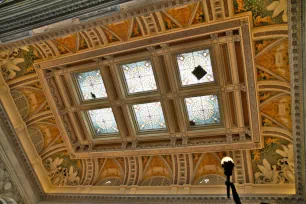One of the largest and best-equipped libraries in the world, The Library of Congress houses 90 million items on 540 miles (869 km) of shelves.
History


The concept of establishing a library for the use of members of Congress dates all the way back to 1800, when it was decided to create a library in the US Capitol. The library was destroyed when the Capitol was set on fire by British troops, but Thomas Jefferson donated his own personal library as a replacement. For nearly a century, the library did not have a dedicated location.
In 1886, however, the first separate Library of Congress building was authorized. At that time, the then Librarian of the Congress, Ainsworth Rand Spofford, drew up plans and presented them for approval. However, it wasn’t Spofford’s plans that were ultimately used for the construction of what was to become known as The Jefferson Building of the Library of Congress.
The architects chosen for the task were John L. Smithmeyer and Paul J. Pelz who designed an impressive Italian Renaissance building. The two architects were later dismissed and replaced with architect Edward Pearce Casey and civil engineer Bernard R. Green. An additional forty-two sculptors and painters were also part of the construction, and their works grace the elaborate interior of the library.
Interior of the Library


The new Library of Congress opened in 1897. Its interior design was based on the Paris Opera House and was constructed of marble, granite, iron, and bronze. It has many classical characteristics, such as Ionic columns and relief sculptures, and features numerous statues.
In the main reading room, eight large marble columns support 10-foot-tall (3 m) allegorical female figures, made of plaster and representing commerce, history, art, philosophy, poetry, religion, law and science. In addition, another sixteen bronze allegorical statues sit on the balustrades of the galleries.
The main entrance hall – known as the Great Hall – is just as impressive. It is decorated with beautiful mosaics and murals. Monumental marble staircases lead to a colonnaded hall on the upper floor.
Expansions
In 1930, an Annex Building was constructed on land directly east of the main building. It is best described as a classical building with Art Deco details, typical of the era during which it was built. It was designed by Washington architectural firm Pierson & Wilson, with Alexander Buel Trowbridge as consulting architect. The building, now known as the Adams Building, opened in 1939. It can accommodate some 10 million volumes.
The most recent building in the Library of Congress complex was completed in 1981 and is dubbed the Madison Building. At more than 2 million square-feet or about 186,000 square meter in size, it is one of the three largest public buildings in the District of Columbia. It houses the library’s administrative offices, the Congressional Research Service, the Law Library, the Office of the Librarian, the Copyright Office, and eight reading rooms.

